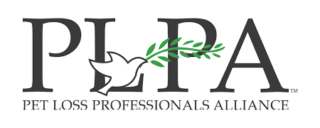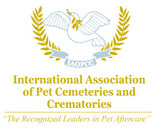This is Part 7 of our Support Protocols for 14 Common Situations series. The cases described in this series are drawn from everyday scenarios found in general veterinary practice or emergency and specialty practices. Below you’ll find an example of a type of case you’re likely to encounter in practice. This blog’s subject is a case involving handling body care options.
 Situation: Handling Body Care Options
Situation: Handling Body Care Options
Berkley, a nine-year old yellow lab, underwent exploratory surgery. During the procedure, Berkley was found to have cancer all through his abdomen. The veterinarian contacted Berkley’s owners, Jim and Marge, and together they decided to euthanize Berkley while he was still anesthetized. Jim and Marge told the veterinarian that they would like to have their dog’s body back for burial.
Thinking that his clients would probably not want to see their pet after death, the veterinarian placed Berkley in a large, black plastic bag and sealed it tightly with a twist tie. When the clients arrived an hour later to pick up Berkley’s body and were given the bag, they were confused. They believed their dog had been too big to fit into the bag that was lying in front of them on the floor of the examination room. Reluctantly, they removed the tie and looked inside. At that point they saw what had been their big, cuddly dog stuffed into a garbage bag, contorted into a grotesque posture. Crying, the clients struggled to carry their dog’s body out to their car and left without even talking to the veterinarian.
When the veterinarian was told that his clients had left abruptly, he felt confused and a bit angry. He thought he had done what his clients had asked him to do and had handled the body in the way he thought would be best for them. He didn’t understand their reaction.
Assessment: What’s Going On Here?
Care of a pet’s body following death is a delicate issue in terms of the client/veterinary professional relationship. Since many owners have invested many years, much love and a substantial amount of money in the physical care of their companion animals, their pet’s body remains important to them even after death. When clients perceive that their pet’s body has not been treated with respect and reverence, their grief is often exacerbated, and the relationship with their veterinarian severely jeopardized.
This is what we see in the example above. The clients knew their dog was being euthanized, but they assumed that the body would be treated respectfully. The veterinarian, however, did not realize how important this issue can be to clients. The mismatch between client expectations and reality caused a major breach in the relationship. More important, the veterinarian missed an opportunity to help his clients with the grieving process and probably made the situation more painful for them.
Please note: Since the original publication of this text, many changes have happened in the pet aftercare industry. The first is, a new AVMA Aftercare Policy. Our friends at Euthabag have put together a fantastic page explaining this new policy: www.euthabag.com/avma-aftercare-guidelines
Second, preferences for body care have evolved and new choices have been made available like aquamation. Be sure to research the options you have available to you in your area so you are presenting your clients with all potential options.
It’s sometimes tempting to judge your clients’ body care decisions. For example, there are clients who choose to have their horse cremated, spending thousands of dollars to do so. Others bury their companion animal in an expensive casket similar to those used for humans, or even hire taxidermists to preserve their pet’s body so it retains the same appearance after death that it had in life. When it comes to body care, the measure of success is not whether your clients make the body care decision that you believe is right, practical, moral, or even sane. Rather, success is achieved when you facilitate honest, open, nonjudgmental discussions about body care and help your clients arrive at decisions that are right for them. These are the body care decisions that bring both you and your clients peace of mind.
Plan: Support Protocol for What to Say and Do
Lay the Foundation (Step 1)
-
Help Clients Make Decisions
Whenever possible, help clients make decisions about body care prior to the death of a companion animal. Owners should be offered all the body care options (FREE Client Handout) that are available to them, and each option should be explained honestly and in a sensitive manner. The cost of each option should also be disclosed. If bringing up the topic of body care causes your own anxiety level to rise, say something like “This subject is always difficult for me to talk about, but I need to know what you would like to do with Berkley’s body.” It’s wiser to reveal your own vulnerabilities than to make hurtful assumptions regarding your clients’ wishes.
-
Communicate Options
- Explain body care options in a private area.
- Use a conversational, quiet voice and respond to your clients’ tears or questions with touch, attending behaviors, and honesty.
- When discussing body care options, you might say, “Jim and Marge, I can offer you three options for taking care of Berkley’s body after he dies. The first option is for you to take him with you and bury him in a pet cemetery or appropriate place on your own property. If that is your choice, we encourage you to bring something like a blanket or a nice box from home to transport his body in because our options here are limited to large plastic bags or vinyl caskets, which would incur an additional cost. Second, you can cremate Berkley’s body and either keep his cremains, dispose of them yourself, or ask the crematory to dispose of them for you. If you want the crematory to return them to you, and you decide to keep them rather than scatter them outdoors, you may wish to choose an urn or another kind of container to keep them in. Cremation or aquamation are popular and practical body care options for pets because so many people in our society move quite often. This way, you can always take your pet with you. Your third option is to have us take care of Berkley’s body for you. Although I wish I had a more pleasing option to offer you, my only option is [mass incineration, mass burial at the local landfill, or delivery to a rendering company — fill in the blank with whatever is accurate for your area].”
- Since the majority of mass burials take place in landfills, clients should be given this information. Though it might not matter to some of your clients, the thought of burying their companion animal at a landfill might be quite distasteful to others.
-
Details Matter
Use visual aids, along with demonstration and written information, during this explanation. For example, if your practice is able to make caskets or urns available for owners to purchase, samples and pricing can be shown. You can also offer to show your clients what the cremains of a dog or cat look like. Many people think that cremains are like the gray, papery ashes that remain in a fireplace after a log has been burned, but they are actually more like sand or small pebbles, often with larger chips of bone included.
-
Children
Body care options also sometimes need to be explained to children. It’s helpful to draw pictures and use appropriate props such as caskets, urns, and cremains to explain the concepts to kids. Think ahead about how you will explain these options to children, and make sure the parents approve of including the children in the discussion ahead of time. Some parents like to shield children from these matters, but when it is done with sensitivity, including children in these talks is often helpful to them.
Implement Support Techniques (Step 2)
-
Normalize Body Care Choices
A pet owner may feel foolish about his or her desire to bury or cremate a pet, particularly if the companion animal is large (e.g., a horse or llama) and doing so is very expensive. Burial and cremation of animals are more common all the time, however, and there is no reason a client should feel embarrassed about making one of these choices.
-
Avoid Misunderstandings
To avoid a misunderstanding like the one described in the opening scenario, try to have something other than plain cardboard boxes or plastic garbage bas on hand to return bodies in. There are several items that are better alternatives. Blankets or towels, for example, can be bought very inexpensively at yard sales or thrift stores. Inexpensive cardboard caskets and body bags made specifically for the veterinary market are also available.
-
Prepare Clients
Before clients pick up a pet’s cremains, prepare them for what they will see and feel regarding the transformation that has taken place. For many owners, the difference in size, volume, and weight between a furry body and a container of cremains can be shocking and emotionally overwhelming. Encourage the client to bring a friend or family member along and to bring a small box or basket in which to carry the cremains, unless you know the pet crematory you are working with supplies something like this already.
-
Give Clients a Chance to Provide Items from Home
If the client is aware that a pet’s death is imminent, as with a scheduled euthanasia, you may ask them to bring something from home in which to wrap or transport the pet’s body. Then you can be certain that the client will feel the item used is appropriate.
-
Discussing Necropsy
There are times when it may be desirable to perform a necropsy on an animal that has died. Where necropsy is warranted, the option must be tactfully introduced and explained to the client. Several points are relevant to tactful discussions of necropsy:
- Most pet owners are unfamiliar with the term “necropsy” but are familiar with “autopsy” or “postmortem examination.” Define the new word in terms of these familiar words.
- A cosmetic necropsy, in which only selected tissues are removed, is usually recommended when a pet owner wants to find out why the animal died but also wants the body returned for burial.
- Whether a necropsy is complete or cosmetic, it should never be performed without an owner’s knowledge or permission.
Stay Connected through Follow-up Care (Step 3)
-
Remains Retrieval
Remains retrieval is a very important and often overlooked aspect of body care following the death of a companion animal. When clients return to the animal hospital to pick up the pet’s body or cremated remains, they often have expectations about how this event will be handled, only to experience something completely different. For example, when retrieving remains, some clients want to sit down and talk with one or more of the veterinary professionals who helped them at the time of death, while others prefer to simply pick up the pet’s body or cremains without talking to anyone. Regardless of how clients want the event structured, a warm expression of condolence and support should be provided by whoever delivers the pet’s body or cremains to the client.
-
Making an Appointment
If clients wish to schedule an appointment for remains retrieval, it is important to set a time for an office visit. Given the sensitive nature of this meeting, it is probably best not to charge the client for this appointment. When the client arrives, he or she should be taken into a private room — your office, an exam room, or the visitation/euthanasia room — and gently presented with the pet’s body or cremains. If possible, use a different room from the one where the client’s pet died.
-
Positioning the Body
If you are keeping the animal’s body in a cooler until the client can view it or pick it up, curl the body into a sleeplike position so that the client will be able to place the body in a casket or easily transport it in a car. It’s a good idea to keep a box, a vinyl casket, Euthabag or another container at your clinic for shaping and storage purposes.
It’s also important to have the body positioned in a way that is pleasing for clients to see and touch when they say their final goodbye. This usually means placing the body inside a box that is padded with towels or a blanket, a cardboard casket, or an animal body bag and allowing the animal’s head to remain outside the container. The preparation also allows clients to quickly and easily enclose the body and to transport it to a car when they are ready to leave your clinic.
-
Sensitive Transport
If the client is taking the pet’s body home, be sure it is not transported out to the client’s car through your busy waiting room.
Handling Body Care Options: Role-Play Ideas
- For hospital managers and client care specialists: Practice greeting clients who have returned to your clinic to pick up their pet’s cremains. Remember to prepare your clients for what they will see and to present the cremains to them.
- For veterinary technicians: Practice supporting clients who must make a decision about body care. Describe the different options and normalize their emotions.
- For veterinarians: Using a situation similar to the opening scenario, practice talking with clients who are unhappy about some aspect of their pet’s body care. Try to find ways to support them and to respond to their anger appropriately. Pay close attention to your verbal and nonverbal communication and to the ways you can avoid becoming judgmental or defensive.
Keep up the good work,

Laurel Lagoni
Co-Founder
World by the Tail, Inc.





